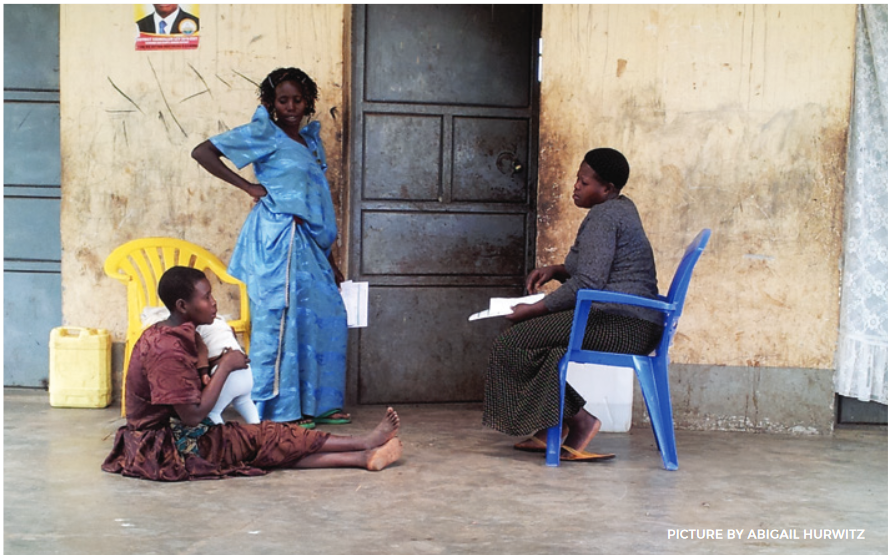
During the first month of my internship with Reproductive Health Uganda (RHU), I accompanied a team of health professionals who were administering reproductive and sexual health services to the camp residents to Nakivale (pronounced na-chi-va-le), a refugee camp in western Uganda. At the camp they provided HIV testing and cervical cancer screenings (checking the cervix for visible irregularities, an array of family planning services, and sexuality counseling and education.
The team, which was made up of members from three different RHU branches, was divided into four groups, and each group covered a different area in the camp. Every day, they would go to a health center, pack equipment, and set out to do outreach. Often, this would mean packing 4x4 vehicle with only five seats with six or seven passengers, medication, condoms, test kits, medical supplies, and portable beds for gynecological exams.
When we reached our destination, we would find available mud and straw huts somewhere in the community, and set up shop for the day, a field clinic magically improvised. These huts were typically homes of residents gracious enough loan it to the healthcare team for the day. The conditions they worked in were quite astounding: tiny spaces with no light, constructed out of improvised materials, corrugated metal, with rocks to prevent the rooves from flying off.
I only had a very vague idea of what a refugee camp would actually look like. For example, I was imagining a temporarily erected, dense area full of people, maybe a few thousand refugees camped in a fenced in area, tents, and a camp center that included a NGOs with different projects and activities. I was imagining something that looks very temporary. Instead, I found 10o,000 residents in Nakivale a fraction of the current 600,000 refugees and asylum seekers in camps around Uganda, one of the largest recipients of refugees in Africa. The country has traditionally demonstrated a deep sense of regional responsibility and with every fresh regional conflict, such as those in in Rwanda, Sudan, Burundi, Uganda receives an influx of refugees through its borders. The population within the camps fluctuates. Some people go home after some time, and some stay for a decade, two decades, or more.
Nevertheless, it is more accurate to call these camps refugee settlements, many of which are expansive. Nakivale covers an area of land that probably takes about three hours to drive through. It includes different districts or sections where people live and each with its own characteristics. These are like villages, where residents can come and go as they please, sometimes work, they live their lives, have babies, get married, and die.
Refugees in such settlements are meant to be in transit, leaving their home temporarily and seeking refuge where they can. UNHCR provides them with food, and they receive free health services and education (most of the time). So, the majority do not work, and they are living on very little, just enough to get by. That might be sustainable for a few months, but when a year, and sometimes years, go by, this transforms their lives into ones of poverty, exploitation, and social structures that promote extreme patriarchy, and crime. There is no long term plan for these refugees, likely because their situation is not framed as a long term, though it often it is.
Life in the camp has profound implications for reproductive health. Many, many children are born in the camps, and there is not enough knowledge about family planning available. A common service the RHU nurses provided was administering or renewing injectable, hormonal birth control implant (commonly known as depo-provera) in women’s arms, though this is not always culturally acceptable. For example, one of the women who received that service returned about an hour later, stating her husband beat her and demanding the implant be removed, making me wonder why the husband, a father of three of very little means, would object to that decision.
Another cultural issue that arose was that many people asked to be tested for syphilis though the practitioners normally did not suggest it, only promoting HIV tests. During my time there, only two people received a positive syphilis test (a mother and son), prompting me to inquire why so many residents request a syphilis test, despite low rates. Practitioners answered that there are abundant misconceptions about the disease in the camp and people assume many unrelated symptoms to be an indication of the disease.
Throughout Uganda, and I can only assume other parts of East Africa, there are local and international NGOs working hard to educate the population about family planning and reproductive health and counter misunderstandings and misconceptions, and they are doing a wonderful job. So far, however, this effort has not been extended to the refugee camps. There are organizations attempting to change that, and hopefully there will be a permanent presence of a reproductive health NGO in the camps in the near future.
The core problem with this transient, presumed-temporary but actually permanent population, is that long-term interventions such as education do not seem to fit in naturally in that context. As we can see from the examples above, reproductive health services and sex education are crucial life-saving services which would ideally be part of the refugees’ day to day lives.
I am left with many questions regarding the refugee issue in East Africa. The temporary-permanent presence of the refugees makes it hard to know what interventions should be planned for this population. What I do know is that as long as there is not a concentrated effort to make sexual and reproductive health readily available, the more vulnerable members of the refugee camps, women and children, will be the ones who suffer most: women who carry the greatest burden of bearing and raising children in poverty, and children who have few resources, opportunities and unclear futures.
Abigail Hurwitz


